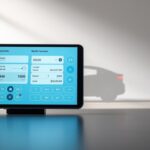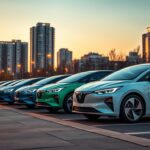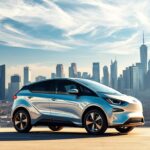
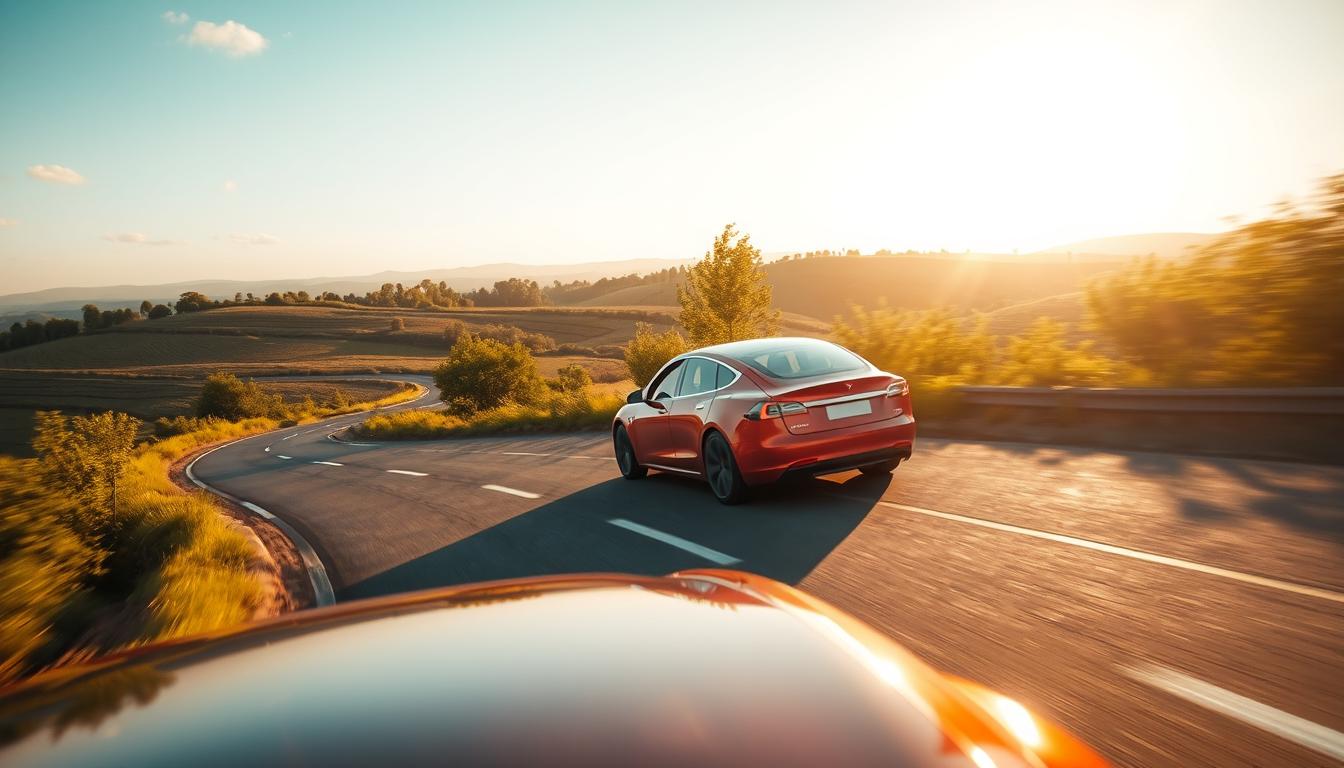
Tesla autopilot
The automotive industry is on the cusp of a revolution, with autonomous driving at the forefront. At the heart of this transformation is Tesla’s advanced driver-assistance system, known as Autopilot.
This innovative technology enables self-driving cars to navigate complex road scenarios with ease, significantly enhancing safety and convenience on the road.
As the technology continues to evolve, it’s clear that Autopilot is paving the way for a future where vehicles can operate independently, transforming the way we travel.
Key Takeaways
- Autopilot is a sophisticated driver-assistance system developed by Tesla.
- The technology is a crucial step towards achieving fully autonomous vehicles.
- Autonomous driving enhances road safety and reduces driver fatigue.
- Self-driving cars are poised to revolutionize the automotive industry.
- The future of transportation is increasingly becoming autonomous.
What Makes Tesla Autopilot Revolutionary
With its cutting-edge technology, Tesla Autopilot is redefining the future of transportation. Tesla’s innovative approach to autonomous driving has set a new standard in the industry, leveraging advanced Tesla technology to enhance safety and convenience on the road.
Core Technology and Vision
Tesla Autopilot’s core technology is built around a comprehensive sensor suite, including cameras, radar, and ultrasonic sensors. This combination enables the vehicle to perceive its environment with a high degree of accuracy. At the heart of Autopilot is Tesla’s advanced neural network, which processes data from the sensor suite to make informed decisions about steering, acceleration, and braking.
The Promise of Autonomous Driving
The promise of autonomous driving extends beyond convenience, offering significant safety benefits. By minimizing human error, Autopilot can reduce the risk of accidents. Moreover, autonomous vehicles can provide mobility for the elderly and disabled, enhancing their quality of life. As Tesla continues to refine its Autopilot technology, the potential for a revolutionary autopilot system that can navigate complex driving scenarios with ease becomes increasingly tangible.
Tesla’s commitment to improving Autopilot through over-the-air updates ensures that its vehicles are always equipped with the latest advancements in Tesla technology, paving the way for a future where autonomous driving is the norm.
The Evolution of Tesla Autopilot
The journey of Tesla Autopilot, from its initial release to the current state, is a story of relentless innovation and improvement. Since its introduction, Tesla Autopilot has undergone significant transformations, driven by advancements in both hardware and software.
Early Development and Initial Release
Tesla Autopilot was first introduced in 2015, marking a significant milestone in the development of autonomous driving technology. The initial release focused on enhancing driver safety and convenience, with features such as lane-keeping and adaptive cruise control.
Hardware Iterations (HW1.0 to HW4.0)
Tesla has continuously upgraded its hardware to support the evolving Autopilot system. The hardware iterations from HW1.0 to HW4.0 have played a crucial role in enhancing the capabilities of Autopilot.
The transition from HW1.0 to HW4.0 has seen significant improvements in processing power, sensor capabilities, and overall system reliability.
| Hardware Version | Release Year | Key Features |
|---|---|---|
| HW1.0 | 2015 | Initial Autopilot hardware with basic sensor suite |
| HW2.0 | 2016 | Enhanced sensor suite and processing power |
| HW3.0 | 2019 | Improved processing and enhanced Full Self-Driving (FSD) capabilities |
| HW4.0 | 2022 | Advanced FSD capabilities and enhanced sensor suite |
Major Software Updates Timeline
Tesla has regularly released software updates to enhance Autopilot’s functionality. Key updates have included improvements to lane detection, traffic light recognition, and overall system performance.
Some notable software updates include:
- Autopilot 8.0: Enhanced visualization and improved safety features
- FSD Beta: Expanded Full Self-Driving capabilities with beta testing
- Autopilot 10.0: Further enhancements to FSD and driver assistance features
How Tesla Autopilot Works
The Tesla Autopilot system is designed with a multi-faceted approach, incorporating a range of sensors and AI-driven decision-making. This complex interplay enables Tesla vehicles to navigate complex driving scenarios with a high degree of autonomy.
Comprehensive Sensor Suite
Tesla’s Autopilot technology relies on a comprehensive sensor suite that includes cameras, radar, and ultrasonic sensors. This combination provides a 360-degree view around the vehicle, enabling it to detect and respond to various driving conditions.
Cameras and Visual Processing
The camera system is a critical component, providing visual data that is processed using advanced algorithms to detect lanes, objects, and other vehicles. Eight cameras are strategically placed around the vehicle to capture a comprehensive view of the surroundings.
Radar and Ultrasonic Sensors
Radar sensors provide additional depth perception, allowing the vehicle to gauge distances and speeds of surrounding objects. Ultrasonic sensors further enhance this capability by detecting close-range objects, facilitating features like automatic parking.
Neural Networks and AI Decision-Making
The data collected from the sensor suite is processed through sophisticated neural networks that enable the vehicle to make informed decisions in real-time. These networks are trained on vast datasets to recognize patterns and predict outcomes, enhancing the vehicle’s ability to navigate complex scenarios.
Tesla’s Proprietary FSD Computer
At the heart of Tesla’s Autopilot system is the proprietary Full Self-Driving (FSD) computer, designed to handle the complex computations required for autonomous driving. This hardware is capable of processing vast amounts of data from the sensor suite, enabling the vehicle to make rapid decisions.
| Component | Function | Key Features |
|---|---|---|
| Cameras | Visual Data Collection | Eight cameras, 360-degree view |
| Radar | Depth Perception | Enhanced object detection |
| Ultrasonic Sensors | Close-range Detection | Automatic parking, object detection |
| FSD Computer | Data Processing | High-performance computing, AI processing |
Current Tesla Autopilot Features
Tesla Autopilot’s current features represent a significant step forward in vehicle automation and driver assistance. These features are designed to enhance safety, convenience, and the overall driving experience.
Basic Autopilot Capabilities
Tesla’s Basic Autopilot is equipped with several key features that improve driving safety and convenience. These include:
Traffic-Aware Cruise Control
This feature allows the vehicle to adjust its speed according to traffic conditions, maintaining a safe distance from the car ahead.
Autosteer and Lane Keeping
Autosteer assists in steering the vehicle within its lane, reducing driver fatigue on long trips.
Emergency Braking and Collision Avoidance
The system can automatically apply the brakes to prevent or mitigate collisions.
Lane Departure Avoidance
This feature helps prevent the vehicle from drifting out of its lane, ensuring safer lane keeping.
Enhanced Autopilot Features
For those who opt for Enhanced Autopilot, Tesla offers additional features that further enhance the driving experience. These include more sophisticated navigation on autopilot and automatic lane changes.
Full Self-Driving Capabilities
Tesla’s Full Self-Driving (FSD) package represents the company’s most advanced Autopilot features. FSD is designed to enable vehicles to navigate complex driving scenarios with minimal human intervention.
Here’s a summary of the key Autopilot features and their benefits:
| Feature | Description | Benefit |
|---|---|---|
| Traffic-Aware Cruise Control | Adjusts speed according to traffic | Reduces driver fatigue |
| Autosteer and Lane Keeping | Assists in steering within the lane | Enhances safety and convenience |
| Emergency Braking | Automatically applies brakes to prevent collisions | Improves safety |
| Lane Departure Avoidance | Prevents drifting out of lane | Ensures safer lane keeping |
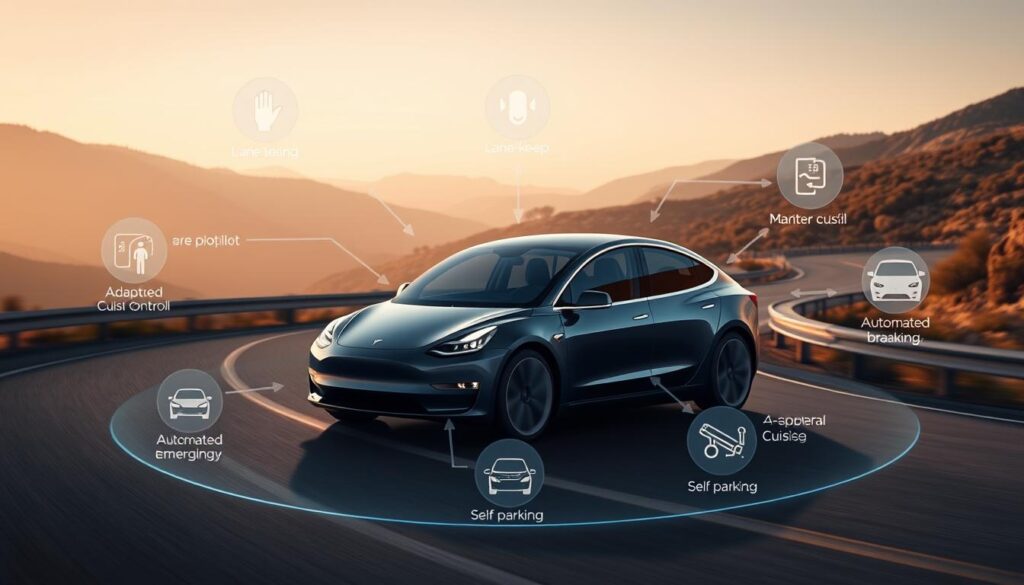
Tesla Autopilot Safety Performance
With numerous vehicles on the road equipped with Tesla Autopilot, understanding its safety record is essential. Tesla Autopilot has been designed with safety in mind, incorporating multiple sensors and AI-driven decision-making to navigate complex driving scenarios.
Comparative Accident Statistics
Studies have shown that Tesla Autopilot is associated with a lower rate of accidents compared to vehicles without autonomous driving features. According to data, Tesla vehicles operating with Autopilot engaged have a significantly lower crash rate per mile than those without Autopilot.
- Tesla Autopilot crash rate: 0.18 per million miles driven
- US average crash rate: 1.85 per million miles driven
NHTSA Investigations and Findings
The National Highway Traffic Safety Administration (NHTSA) has conducted several investigations into Tesla Autopilot, focusing on its safety and effectiveness. The NHTSA has generally praised Tesla’s commitment to safety, noting that Autopilot has contributed to a reduction in crashes.
NHTSA’s key findings include:
- Autopilot reduces the likelihood of crashes
- Tesla’s data collection and analysis improve Autopilot’s safety
- Continuous monitoring and updates enhance safety performance
Safety Improvements Over Time
Tesla has consistently updated and improved Autopilot through software updates, enhancing its safety features. The company’s over-the-air update capability allows for rapid deployment of safety improvements, ensuring that Tesla vehicles remain safe and effective on the road.
The ongoing development of Autopilot and Full Self-Driving (FSD) capabilities underscores Tesla’s commitment to achieving the highest safety standards in the automotive industry.
Tesla Autopilot vs. Competitor Systems
The race for autonomous supremacy is heating up, with Tesla Autopilot vying for top spot against GM Super Cruise, Ford BlueCruise, and Mercedes Drive Pilot. As the automotive industry continues to evolve, understanding how these systems compare is crucial for consumers and industry stakeholders alike.
GM Super Cruise
GM’s Super Cruise system offers advanced hands-free driving capabilities on compatible highways. It boasts an impressive 99.98% safety rate and features a sophisticated driver attention monitoring system. However, its operational design domain is more limited compared to Tesla Autopilot.
Ford BlueCruise
Ford’s BlueCruise is another prominent player in the hands-free driving arena. It offers hands-free driving on 97% of controlled-access highways in the United States and Canada. While it shares some similarities with Tesla Autopilot, BlueCruise is currently limited to pre-mapped highways.
Mercedes Drive Pilot
Mercedes-Benz’s Drive Pilot is a Level 3 autonomous driving system that allows drivers to take their eyes off the road in certain conditions. It’s a significant step towards full autonomy, but its availability is currently limited to specific models and regions.
Waymo and Other Autonomous Systems
Waymo, a subsidiary of Alphabet Inc., is a leader in fully autonomous driving technology. While not directly comparable to Tesla Autopilot due to its more advanced Level 4 capabilities, Waymo represents the future of autonomous driving that Tesla aims to achieve with its Full Self-Driving (FSD) technology.
Comparative Analysis of Capabilities
When comparing these systems, Tesla Autopilot stands out for its over-the-air update capability and extensive network of vehicles providing real-world data. However, competitor systems like GM Super Cruise and Waymo offer more advanced autonomous capabilities in certain areas. The competition is driving innovation, ultimately benefiting consumers.
The Data Advantage: How Tesla Improves Autopilot
With millions of miles driven daily, Tesla’s fleet provides an unparalleled source of data for Autopilot improvement. This vast amount of data is crucial for refining the Autopilot system, making it more efficient and safer.
Fleet Learning and Shadow Mode
Tesla’s fleet learning is a critical component in the development of its Autopilot technology. The vehicles in Tesla’s fleet are constantly collecting data, which is then used to improve Autopilot’s capabilities. Shadow Mode is a key aspect of this process, allowing the system to predict and compare outcomes without interfering with the driver’s actions. This process enables Tesla to refine its algorithms, making Autopilot more accurate and reliable.
The data collected is vast and varied, including different driving scenarios, road conditions, and weather. This diversity helps in creating a robust system that can handle a wide range of situations.
| Feature | Description | Benefit |
|---|---|---|
| Fleet Learning | Data collection from Tesla’s fleet to improve Autopilot | Enhanced Autopilot capabilities |
| Shadow Mode | Predictive analysis without interfering with driver actions | Improved algorithm accuracy |
| Over-the-Air Updates | Remote software updates for continuous improvement | Regular enhancements without physical visits |
Over-the-Air Updates Strategy
Tesla’s over-the-air (OTA) update strategy is a game-changer in the automotive industry. It allows Tesla to push updates directly to its vehicles, ensuring that the Autopilot system is continually improved without the need for physical visits to service centers. This approach not only enhances the user experience but also accelerates the development of autonomous driving capabilities.
By leveraging OTA updates, Tesla can rapidly deploy new features and improvements, keeping its technology at the forefront of the industry. This capability is crucial in the fast-evolving landscape of autonomous driving.
Legal and Regulatory Landscape
Navigating the legal landscape of autonomous driving is crucial for Tesla’s Autopilot technology. As autonomous vehicles become more prevalent, governments worldwide are establishing regulations to ensure safety and efficiency.
Current U.S. Federal Regulations
The U.S. federal government has been developing regulations for autonomous vehicles, including those equipped with Tesla Autopilot. Key regulations focus on safety standards, cybersecurity, and driver monitoring. The National Highway Traffic Safety Administration (NHTSA) plays a crucial role in shaping these regulations.
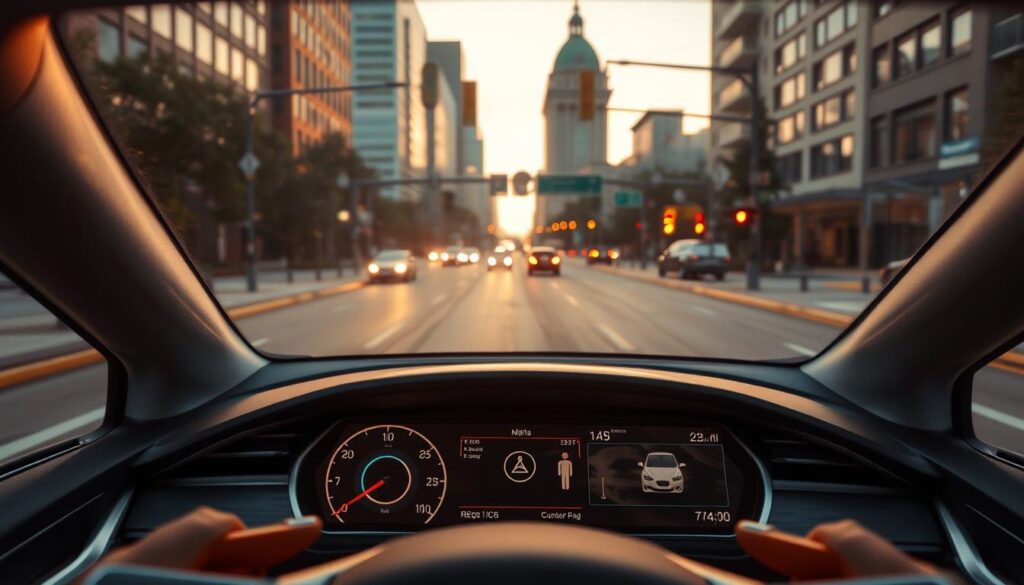
State-by-State Regulatory Differences
While federal regulations provide a baseline, individual states have their own set of rules and guidelines for autonomous vehicles. California, for instance, has been at the forefront of regulating autonomous driving, with specific requirements for testing and deployment. Other states like Arizona and Texas have also established their own frameworks.
International Regulatory Approaches
Internationally, countries are adopting various approaches to regulate autonomous driving. Europe has implemented the General Safety Regulation, which includes provisions for autonomous vehicles. Countries like Japan and China are also developing their own regulatory frameworks, focusing on safety, security, and ethical considerations.
The diversity in regulatory approaches presents both challenges and opportunities for Tesla Autopilot, as the company must navigate these complex legal landscapes to deploy its technology globally.
Controversies and Challenges
Tesla Autopilot has been at the center of several high-profile controversies and challenges since its launch. Despite its innovative approach to autonomous driving, the technology has faced scrutiny from various stakeholders, including regulators, consumers, and the media.
High-Profile Accidents and Investigations
Tesla Autopilot has been involved in several high-profile accidents, some of which have resulted in fatalities. These incidents have triggered investigations by regulatory bodies such as the National Highway Traffic Safety Administration (NHTSA). For instance, there have been cases where Tesla vehicles operating on Autopilot have crashed into stationary objects or other vehicles, raising questions about the safety and reliability of the technology.
| Year | Incident Description | Outcome |
|---|---|---|
| 2016 | Tesla Model S crash in Florida | Fatality, NHTSA investigation |
| 2018 | Tesla Model X crash in California | Fatality, NHTSA investigation |
| 2020 | Tesla Model 3 crash in China | Multiple injuries, regulatory scrutiny |
Marketing Claims vs. Technical Reality
Critics argue that Tesla’s marketing of Autopilot has sometimes overstated its capabilities, potentially misleading consumers about the level of autonomy the technology provides. While Tesla has clarified that Autopilot requires driver attention and is not fully autonomous, the gap between marketing claims and technical reality continues to be a point of contention.
Driver Attention Monitoring Issues
One of the significant challenges facing Tesla Autopilot is ensuring that drivers remain attentive and engaged while the system is in use. Tesla has implemented various measures to monitor driver attention, including camera-based systems. However, there have been instances where these measures have been criticized for not being robust enough, leading to concerns about safety.
In conclusion, while Tesla Autopilot represents a significant step forward in autonomous driving technology, it faces several controversies and challenges that need to be addressed to ensure its safe and effective deployment.
The Future of Tesla Autopilot
Tesla’s commitment to innovation is set to propel Autopilot into a new era of autonomous driving capabilities. As the company continues to advance its technology, several exciting developments are on the horizon.
Upcoming Features and Capabilities
The next generation of Tesla Autopilot is expected to introduce several new features that will enhance its capabilities. Some of the most anticipated features include:
- Improved navigation on complex roads
- Enhanced object detection using advanced computer vision
- Better decision-making through more sophisticated AI algorithms
These advancements will make Tesla’s autonomous driving system more reliable and efficient.
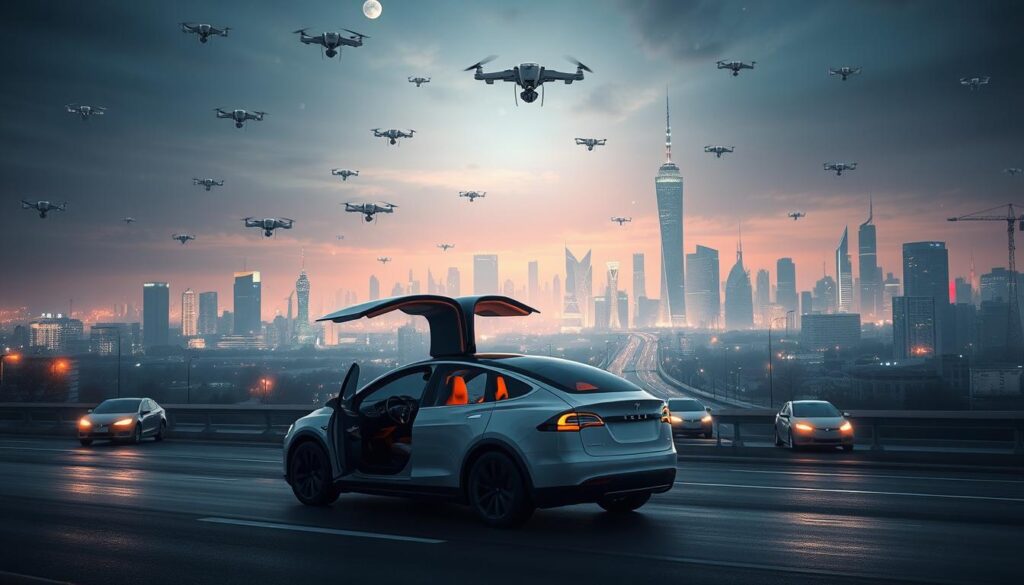
The Road to Level 5 Autonomy
Achieving Level 5 autonomy, the highest level of autonomous driving, is Tesla’s ultimate goal. This level of autonomy means that vehicles will be able to operate without human intervention in all conditions. Tesla is making significant strides towards this goal, with its current Autopilot system already offering a high degree of autonomy.
| Autonomy Level | Description | Tesla’s Current Status |
|---|---|---|
| Level 3 | Conditional Automation | Currently available in Tesla vehicles |
| Level 4 | High Automation | Expected in upcoming software updates |
| Level 5 | Full Automation | Targeted for future releases |
Tesla’s progress towards Level 5 autonomy is a testament to its dedication to pushing the boundaries of what is possible with autonomous driving.
Conclusion
Tesla Autopilot has revolutionized the automotive industry with its cutting-edge technology and continuous improvements. As discussed, its comprehensive sensor suite, neural networks, and AI decision-making capabilities have set a new standard for autonomous driving.
The data collected from Tesla’s vast fleet has enabled the system to learn and improve over time, making it a leader in the field. While there have been controversies and challenges, Tesla continues to push the boundaries of what is possible with Autopilot.
As we look to the future, Tesla Autopilot is poised to play a significant role in shaping the automotive landscape. With ongoing updates and enhancements, the prospect of achieving Level 5 autonomy is becoming increasingly tangible. The future of autonomous driving is bright, and Tesla is at the forefront of this innovation.
FAQ
What is Tesla Autopilot?
How does Tesla Autopilot work?
What are the different Autopilot modes available in Tesla vehicles?
Is Tesla Autopilot safe?
Can Tesla Autopilot be used in all weather conditions?
How does Tesla improve Autopilot through software updates?
What is the difference between Autopilot and Full Self-Driving (FSD) capabilities?
Are there any regulatory challenges facing Tesla Autopilot?
How does Tesla Autopilot compare to competitor systems?
What are the future plans for Tesla Autopilot?
Add a comment Cancel reply
Categories
- Auto Detailing (6)
- Car News (13)
- Car Reviews (10)
- Uncategorized (2)
Recent Posts
About us

Popular Tags
Related posts


New and Second hand EV

